Last Updated on April 27, 2022
Betta fishes (also known as the Siamese fighting fish) are fun to have, not until they show symptoms of diseases that can lead to their death. And scooping out your fish’s body out of the betta tank is something that we don’t want to do!
If you noticed that your betta fish has been acting weird lately, they might have caught some betta diseases.
In this article, we will tackle common betta diseases and how to treat the affected fish.
But before you continue, keep in mind that having a trip to your veterinarian’s clinic is still advisable. Doing so gives you better treatment and care for your sick betta fish instead of doing it all on your own.
Let’s see what are the common betta fish diseases and symptoms below.
| Disease | Symptoms | Treatment |
| Fin Rot | Fins start to melt over time and its remnants will show floating underwater. | Regular aquarium maintenance. |
| Velvet | Rusty scales and black spots show on each part of the betta fishes’ body including the head and gills. | Use a water conditioner to improve the fish tank’s water. |
| Bacterial infection | Symptoms of bacterial infection may vary depending on the disease. | The easy way to treat bacterial infection is to regularly clean your fish tank’s water. |
| Ick | Symptoms include white spots, rings, or dots on the betta fishes’ body. | Change aquarium parameters such as the ammonia and pH nitrates to an optimal level. |
| Fungal infection | May vary depending on the type of fungal infection. | Maintain a clean and healthy environment for your betta fish. |
| Swim Bladder disease | Symptoms include difficulty swimming or floating and standbying too much on the side of the aquarium. | Treatment will vary depending on the reason for the disease. |
| Popeye | As the name suggests, the Popeye disease can make the eyes of your betta fish “pop.†| Clean the aquarium regularly and replace the water on a weekly basis. |
| Dropsy | Betta fish with Dropsy will look bloated, making them look pregnant even though they aren’t. | Regular fish tank maintenance and make sure to do it on a weekly basis. |
| Hemorrhagic | Symptoms include swollen red eyes and mouth that darkens over time. | As deadly it may sound, hemorrhagic is easily treatable and doesn’t pose any problem to your fish if treated early. |
| Eyecloud | Symptoms include white films surrounding the betta fish’s eyes that can accumulate as time passes by. | Eyecloud disease is treatable by regularly maintaining your aquarium water. |
Table of Contents
Fin Rot
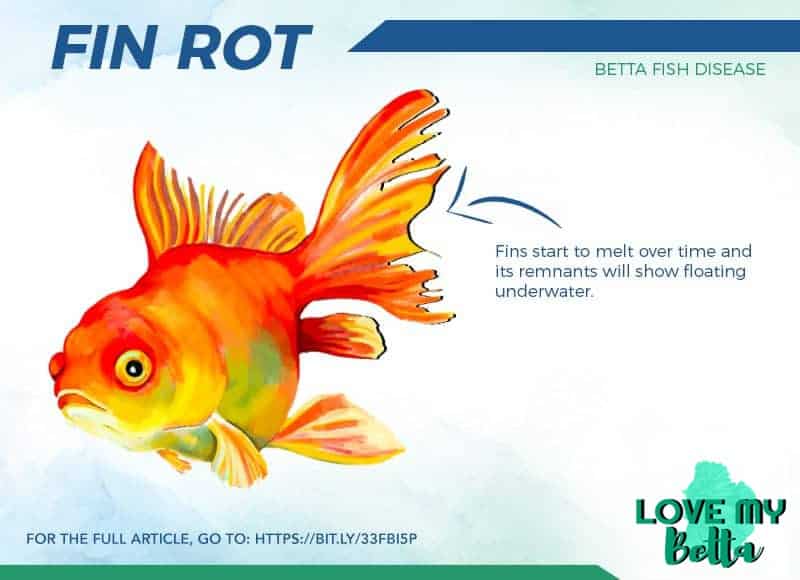
From the name itself, this disease is where the fin of your betta fish rots because of fungi or bacteria. This disease is a result of a lack of fish tank maintenance that results in poor water quality.
Early prevention is a must because the rotting can reach the fin’s base and also lead to tail rot. And once it does, the betta fish cannot regenerate the lost tissue in its fins, leaving them vulnerable to more diseases that can affect some parts of its body.
Fins also fall off in small or large chunks depending on how severe the disease is. It’s treated using antibiotics such as trimethoprim, erythromycin, and sulfadimidine. But keep in mind that medication must be in moderation as it can kill your fish because of it.
Velvet
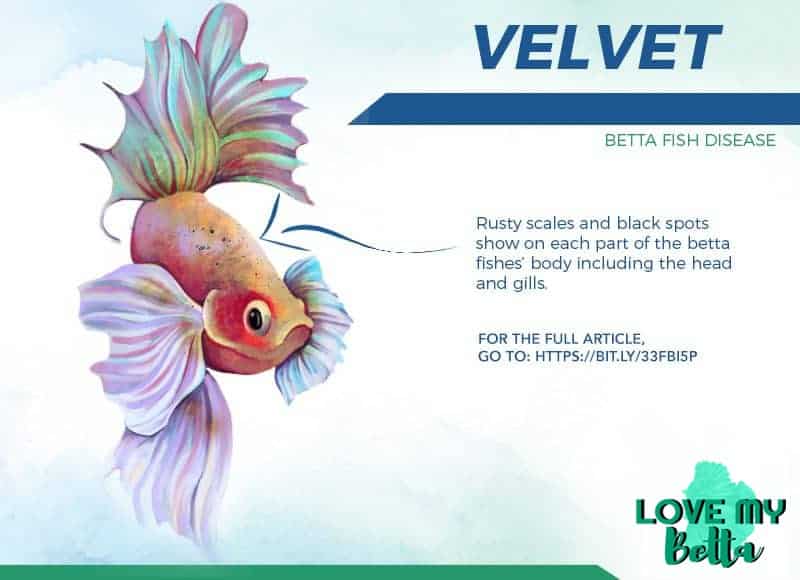
Velvet is a contagious disease caused by a parasite where your betta fish will show rusty spots on its body. If left untreated, it’s deadly to your betta fish and may kill them in just a matter of days.
Its symptoms can turn into a rusty, and brownish golden color that can make your betta fish look unattractive. More symptoms include rapid and inconsistent breathing, skin peeling, and loss of appetite.
For treatment, use a water conditioner to improve the fish tank’s water. Doing so helps promote a healthy environment for your betta fish.
Adjusting the fish tank’s temperature also helps. If symptoms persist, using medication that contains sodium chloride, copper sulfate, and acriflavine will do the trick.
What’s best is that such medication can also treat other fish diseases too. Adding aquarium salt or dimming the lights on some days can also help too.
Bacterial Infection

There are plenty of diseases a bacterial infection may bring about. We have the Columnaris disease where the fins of your betta fish will rag.
There’s also the Mouth Fungus where white lines will show around the mouth of the betta fish that affects their eating.
Symptoms can vary depending on the bacterial infection. For example, if your betta fish has a Columnaris disease, its fins will deteriorate and look soggy as if it will tear apart just like the fin rot disease.
For Mouth Fungus, clumps or white lines will show up on the mouth of the betta fish that can prevent them from eating and swallowing food properly.
In treatment, using a water conditioner should do the trick, but there are also medications available once the bacterial infection goes severe. For Columnaris, treat the open wounds should directly using antibiotics that contain Sulfa 4 TMP, TMP Sulfa, and triple sulfa solutions.
Ick
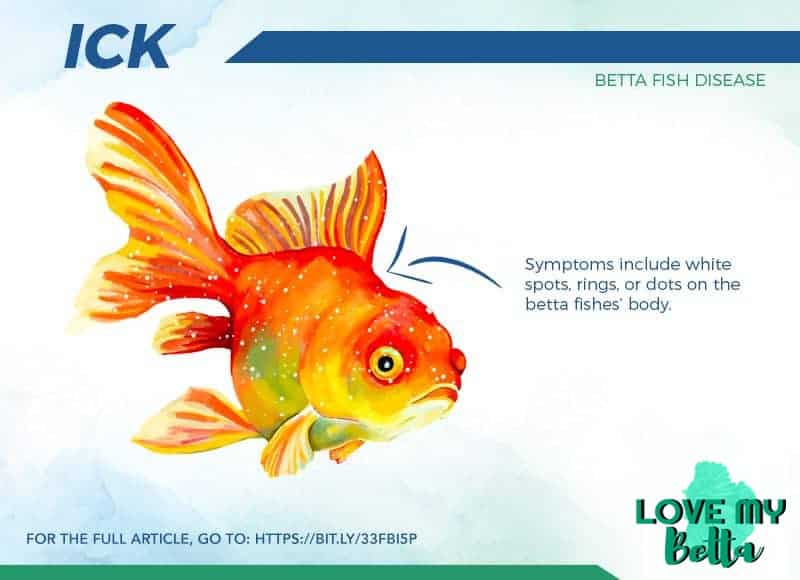
Ick is a common parasitic disease in some fishes, not just betta. You will often find your betta fish scratching against objects when they have ick because of its itchiness.
Symptoms are in spots that can be unsightly to look at and can spread across the fishes’ tails, gills, and belly.
If the infection only happens on the gills, there will be no visible white spots. Symptoms also include gasping for air, clamped fins, and severe itchiness that can damage their skin.
For treatment, create a healthy environment for your betta fish to prevent ich formation. If your fish gets sick because of ich, you can use medication such as the malachite green, or salt baths.
Keep in mind that sickness caused by ick is preventable if they start treatment as early as possible. Adjusting water temperature levels or adding aquarium salt might also help too.
Fungal Infection
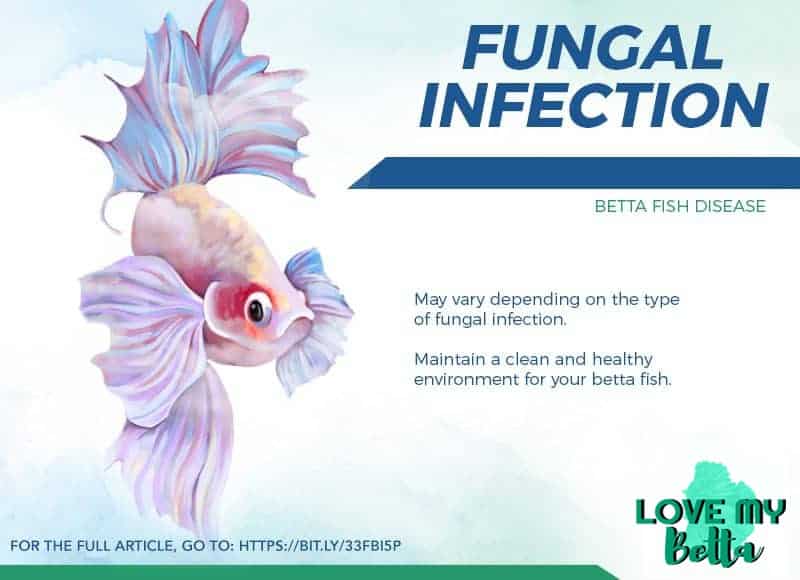
Just like a bacterial infection, fungal infection disease can affect the entirety of a betta fish. Such an example of fungal infections is the Furunculosis and Fish Fungus.
The Fish Fungus disease only occurs because of previous fungus infections and can build up. Symptoms also vary depending on the fungal infection.
For Furunculosis, red and open sores show on the fins and tail of the betta fish. Fish Fungus shows white bumps or lumps on the skins of the betta fish. Untreated fungal infection can also lead to other severe and fatal diseases, making it harder to cure.
Fungal infections are also superficial, which means they only show on the surface and won’t hurt your betta fishes’ internal organs. This includes cotton-like bumps appearing on their skin or gills.
When it comes to treatment, Use a conditioner to improve water conditions and adjust aquarium parameters. Using betta fish antibiotics such as Methylene Blue and Fungus Clear is also viable too.
But keep in mind that using too much medication can kill your betta fish so use it in moderation only. To prevent a fungal infection from coming back more often, always keep your betta fish tank clean and healthy.
Swim Bladder Disease
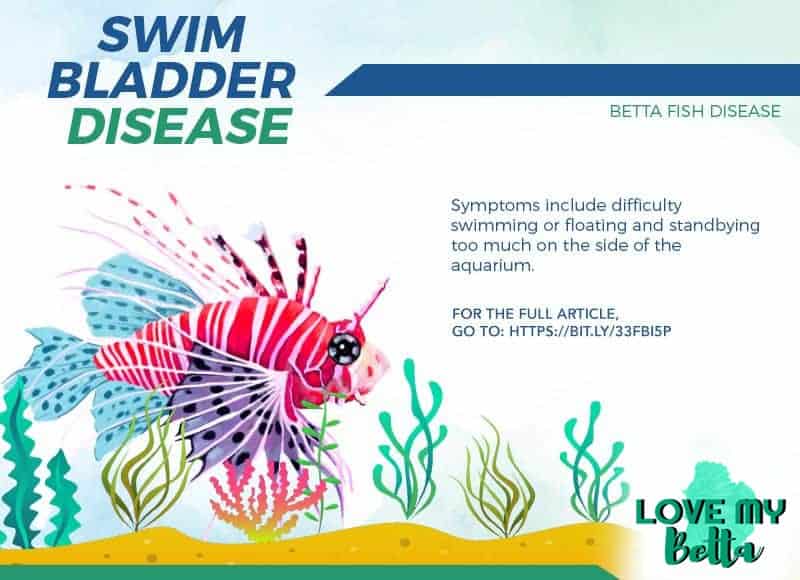
Swim Bladder Disorder happens because of a bacterial infection or genetic dysfunction. Oftentimes, overfeeding can also trigger this disease too.
A betta fish infected by this disease will experience physical abnormalities, resulting in them having trouble floating or sink underwater.
Betta fish with swim bladder disease will have trouble moving its body, preventing them from swimming freely. Betta fishes that have this disease prevents them from maintaining a normal position because of the pain it gives.
Treatment for swim bladder disease varies. If it is because of overeating, letting your betta fish fast for two to three days should suffice. But, if it is because of bacterial infection, use medication such as the Maracyn II antibiotic.
Adjusting your fish tank’s temperature between 78 and 80 degrees Fahrenheit might also help too. Also, adding a small amount of aquarium salt will do.
Popeye
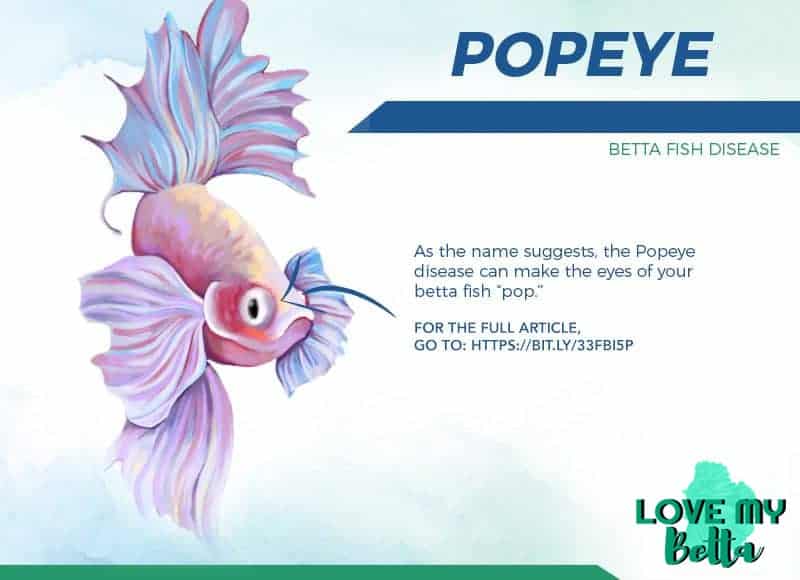
Popeye disease is usually the result of dirty water. Sometimes, it’s caused by tuberculosis too but its occurrence is rare. Luckily, the disease is not fatal and your betta fish can survive just with proper maintenance.
The reason behind popeye is because of the fluid that is leaking behind the betta fishes’ eyeball. As it leaks, pressure builds up on the eyeballs making them pop out of its sockets.
Symptoms include bulge eyes to the point It bulges too much that can negatively affect their vision. This is because it can turn their eyes cloudy or discolored that prevents them from seeing.
Cloudy eyes are a sign of a damaged cornea, which is the transparent covering of the pupil. But, the betta fish can still recover with a blind eye even with no treatment.
Having a clean environment prevents bacteria from building up which can lead to Popeye. If it gets severe, treat it with antibiotics such as Tetracycline to prevent permanent visual impairment.
If a popeye is a result of parasitic infestations that have infected the betta fishes’ skin and gills, visiting your aquatic veterinarian is your only choice.
Dropsy
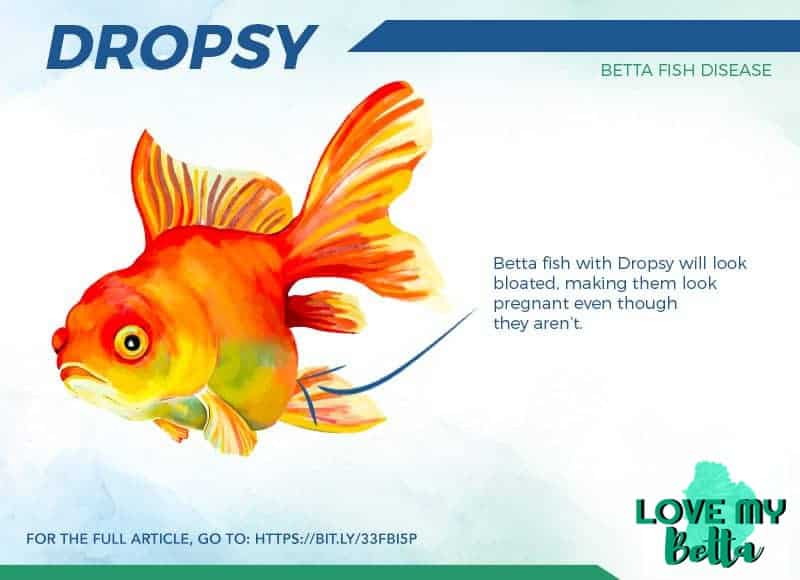
Dropsy is because of a fluid that accumulates inside the betta fishes’ body tissues. If not prevented, it can affect the kidney and can lead to other deadly diseases.
Betta fish that have Dropsy will have a hard time pooping because its anus gets red and swollen. Aside from sunken eyes, other symptoms also include pale gills, ulcers forming up along the lateral line, and a curved spine.
It can also lead to loss of appetite that can turn to starvation in the long run. If it gets severe, Dropsy can make your betta fish lethargic in its environment.
Feeding your betta fish with foods rich in essential vitamins and minerals is the easy way to treat it.
This includes live or frozen foods. You can also feed them with antibiotic fish food in seven to ten days. If it shows no signs of improvement during this period, visiting your vet is your last option.
Hemorrhagic
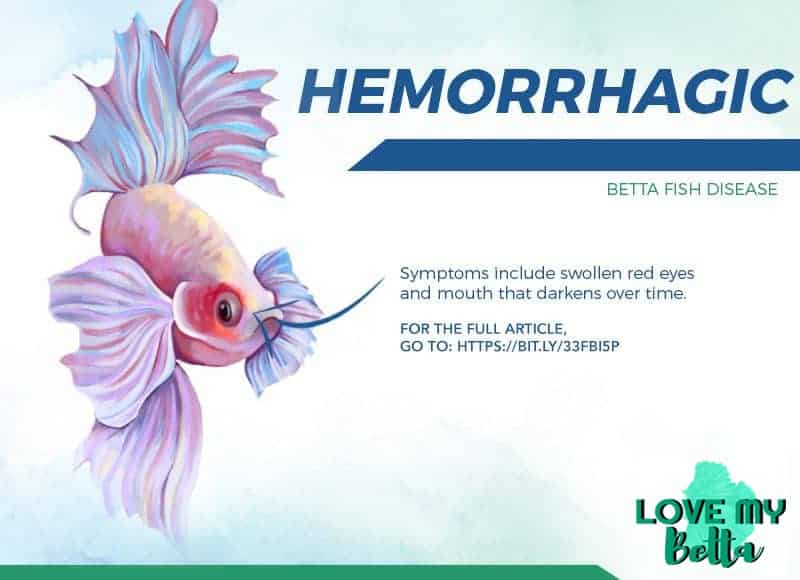
Hemorrhagic, also known as red mouth, is a disease that affects the eyes and mouth of your betta fish. It is the internal bleeding of the eyes and mouth, which can prevent them from seeing and eating properly.
Symptoms can also show on some parts of the betta fish’ body including the abdomen, and gills. Also, symptoms include abnormal swimming patterns and the inability to swallow food.
Treatment only comprises disinfecting your aquarium to ward off viruses and bacteria that cause the bleeding.
Eyecloud
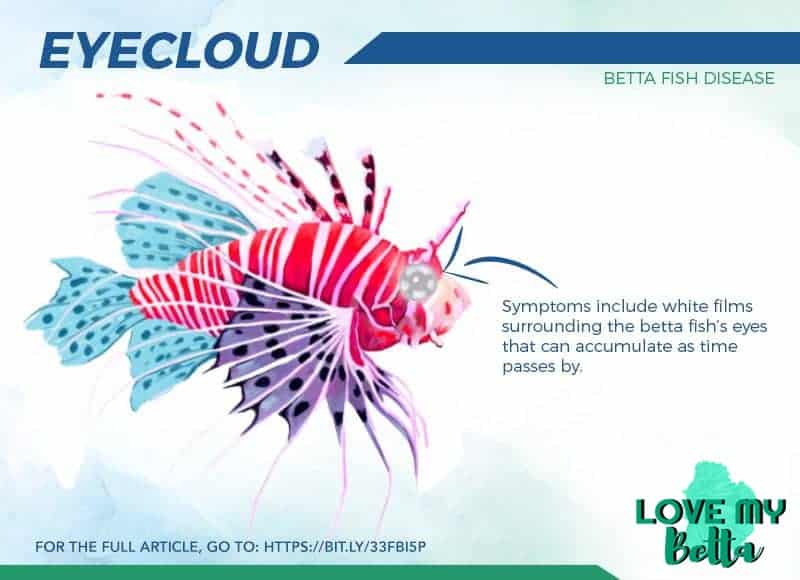
Eyecloud, also known as the cloudy cornea, is a bacterial disease caused by dirty aquarium water or by lack of vitamin, especially vitamin A, that can affect the betta fishes’ eye health.
If not prevented, it can block their vision temporarily since it is not a fatal disease. For treatment, use a water conditioner to keep the fish tank clean, and adjust its nitrate or pH parameters to an optimal level. Alternatively, Eyecloud is also treatable by using antibiotics such as Fungus Clear.
Conclusion
We hope this article helped enlighten you about cleaning your tank water regularly to keep a healthy betta fish. Keep in mind that the health of your betta fish not only lies in the foods you feed them but also in their environment they are living in.
By having a clean betta fish tank, your betta fish can thrive and grow healthily catching none of the aforementioned diseases.
Keep in mind, though, that visiting your vet is still the ideal choice.
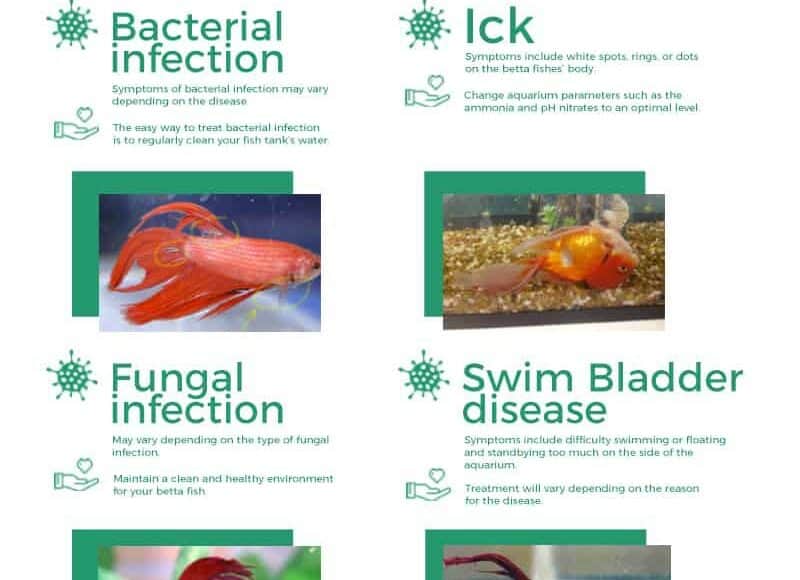
Related: Do Betta Fish Change Color?
